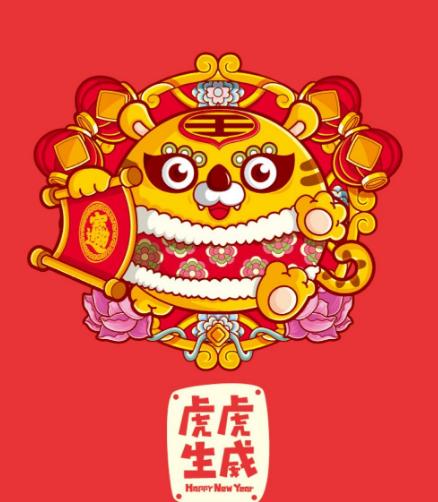Since ancient times, the ancients have known this large, majestic, and gorgeous king of nature, the tiger, and have awe and worship it. In the classical culture of the mainland, the tiger culture occupies an unshakable position, and the tiger is ranked third in the twelve zodiac signs of folk culture, because in ancient times, from three o'clock to five o'clock in the morning was yin time, which was the time when the tiger was most active, and it came out to wander around for food, the most fierce, so it was named "Yin Tiger".

Image from the web
In addition, the image of the tiger also appeared on various life and ritual tools of the ancients, which was endowed with romantic imagination and mythology, and also appeared in children's clothing and the doors of houses, expressing people's good wishes to use the tiger to drive away evil spirits and bless peace, as well as the vision and blessing of a smooth life in the future. Since it is a blessing to welcome the spring, how can there be less "tiger" cultural relics in the Anhui Museum, today I introduce a cute "tiger head shaped huang" for you, and send you the blessings of the Year of the Tiger!
Tiger-headed juan
This is a tiger head shaped Huang, excavated from the Lingjiatan site in Hanshan County, Anhui Province, carved into the shape of a tiger's head, with a drill hole as the tiger's eyes, the side of the tiger's head, carved with a yin carved line, a few strokes will be the tiger's nose, mouth carved out, bent neck under the claw, the head and neck and the body and abdomen to distinguish. The tiger-shaped features of this huangshou are obvious and the appearance is realistic, which shows the accurate grasp of the image of tiger animals by the Neolithic people, and also shows the superb carving technology of the ancients in Lingjiatan. This cute "cute tiger", quietly lying on its stomach in the display case of the Anhui Museum, tells us the historical and cultural information behind it, 5500 years ago.
Double tiger head shaped jade juan
In ancient China, Yu Huang, along with Yu Chun, Yu Bi, Yu Gui, Yu Zhang, etc., are all ceremonial vessels used for "liturgical heaven and earth and four squares". The jade pendant is also often combined with jade pipes and jade strings into ceremonial pendants, and the priest wears them during the sacrifice to show his special identity. But this tiger head-shaped huang may not be an ordinary ornament, but a kind of soldier symbol, similar to what we later often call "tiger charm". Because the site has also unearthed the "Double Tiger Head Shaped Jade Huang", the left and right sides are symmetrical tiger heads, which is the common style of jade huang, and the exhibition hall has obvious cutting marks in the middle of this tiger head shape, which should be half of the complete "double tiger head shaped jade juan", and the two sides of the alliance or troop transfer hold half as a souvenir. In addition to the Tiger Head Jade Huang, the site also unearthed weapons such as jade ge and jade axes, which shows that the ancestors of Lingjiatan have already had acts of war and military alliances.
Lingjiatan ruins
The Lingjiatan site is an important central settlement site in the Yangtze River Basin. It is located in Hanshan County, Ma'anshan City, on the north bank of the Yuxi River, a tributary of the Yangtze River, dating back about 5500 years. After archaeological excavations, the Lingjiatan site has found living areas, independent cemeteries, altars and large-scale braised earth buildings, and the functional area planning is relatively complete. A large number of exquisite jade and stone tools excavated from the Lingjiatan site indicate that it was an important jade-making center in the late Neolithic period of the mainland, and was listed as the three major jade cultural centers in china along with the Hongshan culture in the LiaoHe River Basin and the Liangzhu culture in the Taihu Lake area. The Lingjiatan site is an important representative site of the dawning stage of Chinese civilization and one of the empirical evidences of 5,000 years of Chinese civilization.
This tiger-shaped jade wharf indicates that at least in the Neolithic Age, tigers were very closely related to humans. Historically, there are many records of tigers in the mountainous areas of southern Anhui, especially in the local records of the ancient Huizhou counties, after the two Song Dynasties, a large number of northern populations moved to the southern Anhui region, people's reclamation of land, the felling of trees, directly affected the living conditions of tigers, and the contradictions between people and tigers have become more and more prominent, so the phenomenon of official organized tiger fighting is not uncommon. Coupled with the fact that the whole body of the tiger is a treasure, "tiger bone", "tiger gall" and "tiger skin" are precious medicinal materials or fur, driven by interests, the spontaneous hunting of tigers by the people has also led to a sharp decrease in the number of tigers in Anhui, and there are almost no written records of tigers in Anhui after the Qing Dynasty.
The spring breeze first arrived in the Year of the Tiger, and the sound of joyful songs sounded in the clouds. On the occasion of the New Year, I wish you: blessings and good fortune!
Text: Zhang Peng
finish